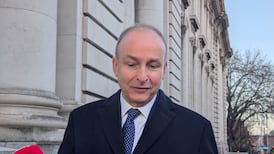It is early days for Radio Ireland, but the new national radio station has had a stumbling start. Behind the high-profile departures of presenters, the financial picture is grim. In January this year, the station's marketing manager said it had the relatively modest aim of taking 10 per cent of the £40 million radio advertising cake. Speaking to The Irish Times, Radio Ireland chairman, Mr John McColgan, said he believed the market share was around 4 per cent.
Based on a total radio advertising market of £40 million, the station's share represents around £1.6 million, but Mr McColgan said he could not confirm if the percentage translated directly to this figure.
The predicted annual running costs for the station were put at around £4 million and the shareholders said the finance was in place to give the station three years before it would have to return a profit.
Advertising agencies were initially well-disposed to any new arrival that would provide real competition to RTE. But the honeymoon does not last when advertising clients demand media that give the maximum audience for the minimum spend.
The main shareholders in Radio Ireland are Scottish Radio Holdings, which took a 15 per cent stake, concert promoter, Denis Desmond, with 6.5 per cent, the State-owned bank, ICC Venture Capital, with 23 per cent and the remainder controlled by five shareholders, including the Riverdance partners, John McColgan and Moya Doherty.
Mr McColgan said last night that the investors, who meet regularly, have expressed their support and are aware of the teething problems that a new media venture faces. As a result, the shareholders have committed a further £2.5 million to cover the station's first year on top of the initial investment of £3 million.
With the collapse of Century Radio still fresh in the mind of advertising agencies, the dismal first set of figures for Radio Ireland will not encourage hopes that there can be a viable alternative to RTE. However, things have changed since Century.
Radio Ireland does not have the transmission problems that dogged Century, having spent £1.3 million on transmitters to ensure a nationwide coverage.
But, unlike Century, the station is facing a fiercely competitive network of local radio stations which have gained a real foot-hold during the last five years. Yesterday's figures showed that local radio has a 45 per cent market share, more than twice that of RTE's 2FM.
Mr McColgan admits the station has failed to promote itself enough and that large numbers of people do not know where the station is on the radio dial.
The station has a 10-year contract from the Independent Radio and Television Commission (IRTC). It pays a 3 per cent levy on its advertising to the IRTC and is subject to an annual review by the IRTC.
Since its launch, Radio Ireland has replaced two of its talk shows, the Cliona Show and Entertainment Today with music programmes. The IRTC stressed that it has a flexible attitude towards the start-up of any radio station.
"The Commission is very aware that it's going to take some time for them to get going. The market is very much more competitive and new projects take time to sell," a spokesman said.
The IRTC has not cracked the whip over the summer schedule changes and the increase in music content. However, the promised new autumn schedule will have to redress the balance of music to talk, unless the station can renegotiate its contract.
Mr McColgan said the new autumn schedule should be on the air by the end of next month, or by the beginning of October. Mr McColgan did not rule out a change in presenters or further attempts to head-hunt talent from outside.
Apart from the Radio Ireland content, yesterdays JNLR figures showed little change in the overall listenership landscape. Market share had stabilised with the steady rise of local radio appearing to settle at its current level.
RTE still appeals to the older listener and its age profile seems to reinforce Radio Ireland's original market pitch at the younger end of the market. However, the new station has failed to prise enough of these listeners away from the independents.
Despite the confidence that the station can ride out a rough start, the listenership figures could hamper Radio Ireland's attempt to re-invent itself.
The JNLR report is the media-buyer's bible, a copy can be found in every advertising agency, with media planners using it to place advertisements in specific radio slots. Until the next set of figures is published, Radio Ireland will wear the 1 per cent label around its neck.
The cut-throat nature of the market was summed up in a statement by Georgina Caraher, media director of Youngs Advertising. She said the station had a week to come up with "significant plans" for the future.
Radio Ireland will be presenting a new pitch to advertisers and a new pitch to the public. Mr McColgan said the station will have to be turned around within the next year.
Whether or not this will work will not be known until the JNLR releases its next figures in six months.






